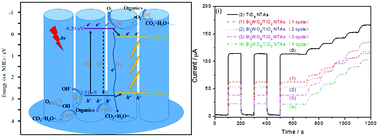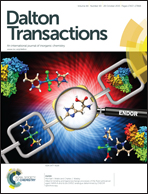Photoelectrochemical properties and the detection mechanism of Bi2WO6 nanosheet modified TiO2 nanotube arrays
Abstract
Bi2WO6 nanosheet modified TiO2 nanotube arrays were synthesized by an anodization method combined with sequential chemical bath deposition for enhancement of the photoelectrochemical detection performance. The structures, morphologies and elemental compositions of the nanotube arrays were characterized with X-ray diffraction, scanning electron microscopy and X-ray photoelectron spectrometry. Bi2WO6 nanosheets were successfully deposited on the tube walls of TiO2 nanotubes. The photoelectrochemical property of Bi2WO6/TiO2 NTAs was determined with chronoamperometry and cyclic voltammetry using an electrochemical workstation equipped with a UV LED light (365 nm). The optimum detection sensitivity of glucose in water was determined to be 0.244 μA mM−1 in the linear range from 0 to 2500 μM. Bi2WO6 modification on TiO2 NTAs simultaneously decreased the background photocurrent and increased the current response to organics, resulting in the enhancement of photoelectrochemical detection properties. Mechanisms of the Bi2WO6 modification are discussed by analyzing the photoelectrochemical processes, including optical absorption, charges transfer and surface electrochemical reactions. Direct oxidation by holes rather than indirect oxidation by ˙OH radicals is believed to be a key role in this enhancement.


 Please wait while we load your content...
Please wait while we load your content...